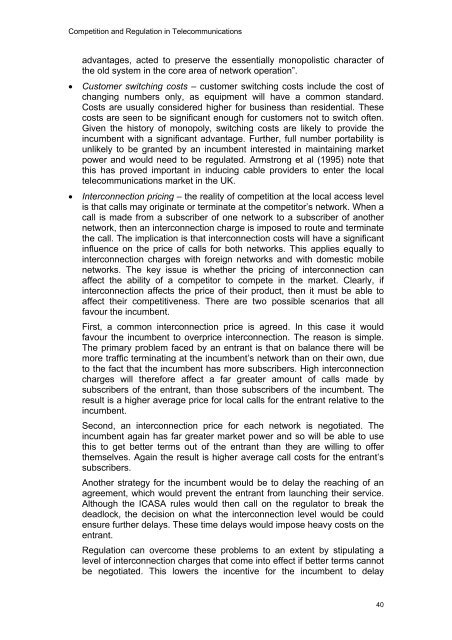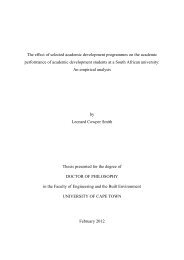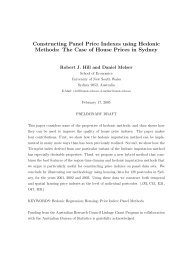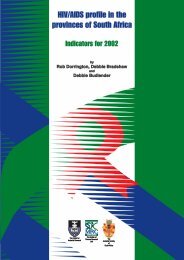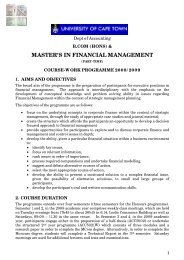Competition and Regulation in the Telecommunications Industry in ...
Competition and Regulation in the Telecommunications Industry in ...
Competition and Regulation in the Telecommunications Industry in ...
You also want an ePaper? Increase the reach of your titles
YUMPU automatically turns print PDFs into web optimized ePapers that Google loves.
<strong>Competition</strong> <strong>and</strong> <strong>Regulation</strong> <strong>in</strong> <strong>Telecommunications</strong>advantages, acted to preserve <strong>the</strong> essentially monopolistic character of<strong>the</strong> old system <strong>in</strong> <strong>the</strong> core area of network operation”.• Customer switch<strong>in</strong>g costs – customer switch<strong>in</strong>g costs <strong>in</strong>clude <strong>the</strong> cost ofchang<strong>in</strong>g numbers only, as equipment will have a common st<strong>and</strong>ard.Costs are usually considered higher for bus<strong>in</strong>ess than residential. Thesecosts are seen to be significant enough for customers not to switch often.Given <strong>the</strong> history of monopoly, switch<strong>in</strong>g costs are likely to provide <strong>the</strong><strong>in</strong>cumbent with a significant advantage. Fur<strong>the</strong>r, full number portability isunlikely to be granted by an <strong>in</strong>cumbent <strong>in</strong>terested <strong>in</strong> ma<strong>in</strong>ta<strong>in</strong><strong>in</strong>g marketpower <strong>and</strong> would need to be regulated. Armstrong et al (1995) note thatthis has proved important <strong>in</strong> <strong>in</strong>duc<strong>in</strong>g cable providers to enter <strong>the</strong> localtelecommunications market <strong>in</strong> <strong>the</strong> UK.• Interconnection pric<strong>in</strong>g – <strong>the</strong> reality of competition at <strong>the</strong> local access levelis that calls may orig<strong>in</strong>ate or term<strong>in</strong>ate at <strong>the</strong> competitor’s network. When acall is made from a subscriber of one network to a subscriber of ano<strong>the</strong>rnetwork, <strong>the</strong>n an <strong>in</strong>terconnection charge is imposed to route <strong>and</strong> term<strong>in</strong>ate<strong>the</strong> call. The implication is that <strong>in</strong>terconnection costs will have a significant<strong>in</strong>fluence on <strong>the</strong> price of calls for both networks. This applies equally to<strong>in</strong>terconnection charges with foreign networks <strong>and</strong> with domestic mobilenetworks. The key issue is whe<strong>the</strong>r <strong>the</strong> pric<strong>in</strong>g of <strong>in</strong>terconnection canaffect <strong>the</strong> ability of a competitor to compete <strong>in</strong> <strong>the</strong> market. Clearly, if<strong>in</strong>terconnection affects <strong>the</strong> price of <strong>the</strong>ir product, <strong>the</strong>n it must be able toaffect <strong>the</strong>ir competitiveness. There are two possible scenarios that allfavour <strong>the</strong> <strong>in</strong>cumbent.First, a common <strong>in</strong>terconnection price is agreed. In this case it wouldfavour <strong>the</strong> <strong>in</strong>cumbent to overprice <strong>in</strong>terconnection. The reason is simple.The primary problem faced by an entrant is that on balance <strong>the</strong>re will bemore traffic term<strong>in</strong>at<strong>in</strong>g at <strong>the</strong> <strong>in</strong>cumbent’s network than on <strong>the</strong>ir own, dueto <strong>the</strong> fact that <strong>the</strong> <strong>in</strong>cumbent has more subscribers. High <strong>in</strong>terconnectioncharges will <strong>the</strong>refore affect a far greater amount of calls made bysubscribers of <strong>the</strong> entrant, than those subscribers of <strong>the</strong> <strong>in</strong>cumbent. Theresult is a higher average price for local calls for <strong>the</strong> entrant relative to <strong>the</strong><strong>in</strong>cumbent.Second, an <strong>in</strong>terconnection price for each network is negotiated. The<strong>in</strong>cumbent aga<strong>in</strong> has far greater market power <strong>and</strong> so will be able to usethis to get better terms out of <strong>the</strong> entrant than <strong>the</strong>y are will<strong>in</strong>g to offer<strong>the</strong>mselves. Aga<strong>in</strong> <strong>the</strong> result is higher average call costs for <strong>the</strong> entrant’ssubscribers.Ano<strong>the</strong>r strategy for <strong>the</strong> <strong>in</strong>cumbent would be to delay <strong>the</strong> reach<strong>in</strong>g of anagreement, which would prevent <strong>the</strong> entrant from launch<strong>in</strong>g <strong>the</strong>ir service.Although <strong>the</strong> ICASA rules would <strong>the</strong>n call on <strong>the</strong> regulator to break <strong>the</strong>deadlock, <strong>the</strong> decision on what <strong>the</strong> <strong>in</strong>terconnection level would be couldensure fur<strong>the</strong>r delays. These time delays would impose heavy costs on <strong>the</strong>entrant.<strong>Regulation</strong> can overcome <strong>the</strong>se problems to an extent by stipulat<strong>in</strong>g alevel of <strong>in</strong>terconnection charges that come <strong>in</strong>to effect if better terms cannotbe negotiated. This lowers <strong>the</strong> <strong>in</strong>centive for <strong>the</strong> <strong>in</strong>cumbent to delay40


